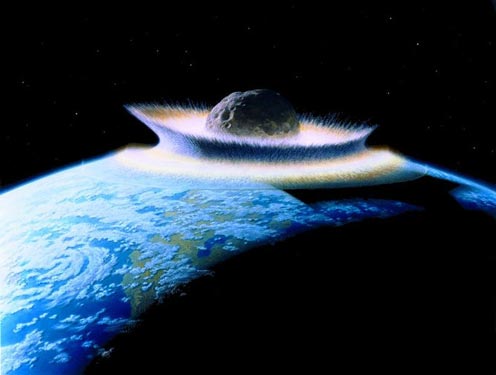Casting Doubts on Global Firestorms
Extraterrestrial Impact May Not Have Caused Global Firestorms
The debate over the consequences of the extraterrestrial impact that took place around sixty-six million years ago continues with the publication of pioneering new research that investigates whether or not the Yucatan impact caused extensive firestorms on a global scale. It is now widely believed that at least one huge object from outer space crashed into Earth which very probably contributed to the mass extinction event that marks the end of the Cretaceous. This is perhaps the most famous of all the mass extinction events recorded in the Phanerozoic fossil record, as no significant quantities of dinosaur fossils are found in younger strata.
Mass Extinction Event
The end Cretaceous mass extinction event saw the demise of the Dinosauria, the pterosaurs, most of the marine reptiles and a number of other significant casualties. It had been thought that a consequence of the impact was a series of huge fires that ravaged the Earth, destroying much of the plant-life on the planet. Plenty of evidence for this catastrophic event has been cited, for example, large amounts of carbon preserved in strata at the K-T boundary, believed to be the preserved remains of such conflagrations.
In 2013, for example Everything Dinosaur published an article on this blog citing research which suggested that intense heat in the atmosphere did indeed cause huge fires: Cretaceous Mass Extinction Study Provides Evidence of Global Firestorm.
A “Fern Spike”
Scientists have also recorded evidence of a “fern spike” that occurred immediately after the extinction event. Large numbers of fossilised fern spores have been recorded (microfossils), in contrast to a very low level of other plant remains such as pollen from flowering plants being recorded. Ferns are quick to re-colonise an area after a devastating volcanic eruption. The “fern spike” data was taken as supporting evidence for the massive destruction of much of the planet’s green matter.
To read more about the “fern spike” research: Humble Ferns – Evidence to Support the Impact Theory.
Did the Extraterrestrial Impact Cause Global Firestorms?
Picture credit: Don Davis commissioned by NASA
Global Firestorms
However, a team of UK based researchers (University of Exeter, Imperial College London and the University of Edinburgh), have challenged the idea of world-wide fires. The scientists recreated the massive energy released from the impact event and they found that the blistering heat near the impact site was too short-lived to ignite living plants. The scientists conducted a series of experiments using pulses of heat and writing in the Journal of the Geological Society, the team conclude that close to the actual impact, the heat wave would have lasted less than a minute, too short a time to set fire to living plants.
However, using computer models they discovered that the effects of the blast would have been felt as far away as New Zealand, some 12,000 kilometres from the site of the explosion. The further away from the blast centre, the less intent the heat wave, but it would have been longer lasting. In New Zealand, the heat blast would have lasted for around seven minutes, long enough to ignite living plant material.
Living Plants Not Ignited
Experiments conducted suggest that dry and dead plant matter could be set alight, but live plants such as conifer needles were not ignited.
Having a Blast with Heat Wave Experiments
Picture credit: University of Exeter
The picture above shows the fire propagation apparatus recreating the impact induced thermal pulse at the Cretaceous/Palaeogene (K-T boundary). Halogen lamps are delivering the intense, thermal radiation.
Commenting on the study, Dr Claire Belcher (Earth System Science group in Geography at the University of Exeter) stated:
“By combining computer simulations of the impact with methods from engineering we have been able to recreate the enormous heat of the impact in the laboratory. This has shown us that the heat was more likely to severely affect ecosystems a long distance away, such that forests in New Zealand would have had more chance of suffering major wildfires than forests in North America that were close to the impact. This flips our understanding of the effects of the impact on its head and means that palaeontologists may need to look for new clues from fossils found a long way from the impact to better understand the mass extinction event.”
The Impact on Flora and Fauna
Fauna and flora populations are generally resistant to localised fire events, animals can hide or hibernate/enter aestivation and the seeds of plants can survive the intense heat of forest fires. Some plants even rely on seasonal fires to help them spread. Based on these assumptions, it can be suggested that wildfires on their own are unlikely to be directly responsible for extinctions. However, large dinosaurs which were unable to run very far, or shelter may have suffered terribly from such fires.
Dr Rory Hadden from the University of Edinburgh added:
“This is a truly exciting piece of inter-disciplinary research. By working together engineers and geoscientists have tackled a complex, long-standing problem in a novel way. This has allowed a step forward in the debate surrounding the end Cretaceous impact and will help geoscientists interpret the fossil record and evaluate potential future impacts. In addition, the methods we developed in the laboratory for this research have driven new developments in our current understanding of how materials behave in fires particularly at the wildland-urban-interface, meaning that we have been able to answer questions relating to both ancient mass extinctions at the same time as developing understanding of the impact of wildfires in urban areas today.”
Everything Dinosaur would like to thank Exeter University for the use of a press release that enabled this article to be compiled.
Visit Everything Dinosaur’s website: Visit Everything Dinosaur.



